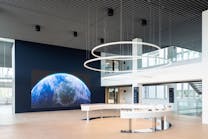Seoul Semi touts new human-centric lighting research showing productivity benefits of SunLike
Seoul Semiconductor has released some details of a research project focused on the SunLike LED technology and human physiological health performed at the Brigham and Women’s Hospital located at Harvard University. Shadab Rahman, a researcher in the Division of Sleep and Circadian Disorders, led the research that documented benefits to several aspects of cognitive and circadian health found in college students exposed to the SunLike spectra. Seoul has, from the introduction of SunLike, touted health and wellbeing or human-centric lighting advantages of SunLike exposure.
Seoul has previously pointed to university research that affirmed its lighting for health claims. For instance, the company announced research done at the University of Basel in Switzerland that documented improved sleep patterns. The National University in South Korea had published similar results.
Still, the research from Harvard will greatly enhance the SunLike brand. Rahman is an extremely well respected researcher and he was also the keynote speaker at a Lighting for Health and Wellbeing Conference that we held back in 2017. Moreover, Steven Lockley, Leilah Grant, and Melissa St. Hilaire were also members of the research team.
“Even if the color temperature and brightness are the same, light with different spectra may affect non-visual responses to light exposure, including those of circadian rhythms and cognition, differently,” said Rahman. “In this experiment, we found improvement in working memory, cognitive processing speed, procedural learning, and testing accuracy with young adults under daylight-like light spectrum lighting compared to conventional-LED spectrum lighting. This is an important result that can inform lighting choices for indoor use to enhance students’ learning and memory function.”
Seoul Semiconductor was quick to tout the accolades delivered by the Harvard team. “As the saying goes, Mother Nature is great, the human body has a 24-hour circadian clock that has evolved to set its time by tracking the daily cycle of sunlight,” said Chung-hoon Lee, CEO of Seoul Semiconductor. “SunLike is a technology that reproduces all wavelengths of visible light as closely as possible to sunlight. We’ve been working on R&D over the past 30 years to optimize this technology to provide plants, animals, and humans access to light that is closest to sunlight to promote healthy circadian rhythms and sleep, which can also help children and students to study effectively and maintain good health.”
The SunLike technology was launched back in mid-2017 by Seoul Semiconductor and Toshiba Materials. Seoul developed the short-wavelength violet pump used by the SunLike technology. Seoul also had deep experience in manufacturing phosphor-converted white LEDs. But it was Toshiba Materials that brought the three-phosphor SunLike mix to the product development effort. More recently, this past September Seoul bought all intellectual property rights to SunLike from Toshiba Materials.
There are of course a lot of angles to LEDs designed for human-centric lighting applications. Many use the blue energy peak associated with a blue-pump LED as the blue energy source for, say, enhancing morning productivity. But more recent research has shown that the circadian sensitivity peak is more in the cyan region as opposed the 450-nm region where most blue pumps operate.
Circadian ZircLight published an article in our magazine earlier this year stating that the peak was at 477 nm. BIOS Lighting has said that the peak is at 490 nm and along with Lumileds has an LED mix called SkyBlue that offers such a peak. Furthermore, at Strategies in Light 2021, BIOS executive Robert Soler presented a paper making the point that the SkyBlue approach had the maximum circadian impact no matter the actual location of the peak. Note that for a brief time you can still register and access the Strategies in Light presentations on demand.
Of course, the SunLike approach is an entirely different animal with no pump in the blue region. SunLike delivers blue energy with a phosphor and indeed has a uniform spectral power distribution (SPD) across the human visual range. No doubt expert researchers will continue to test the limits and benefits of each approach.
LEDs Magazine chief editor MAURY WRIGHT is an electronics engineer turned technology journalist, who has focused specifically on the LED & Lighting industry for the past decade.
For up-to-the-minute LED and SSL updates, why not follow us on Twitter? You’ll find curated content and commentary, as well as information on industry events, webcasts, and surveys on our LinkedIn Company Page and our Facebook page.

Maury Wright | Editor in Chief
Maury Wright is an electronics engineer turned technology journalist, who has focused specifically on the LED & Lighting industry for the past decade. Wright first wrote for LEDs Magazine as a contractor in 2010, and took over as Editor-in-Chief in 2012. He has broad experience in technology areas ranging from microprocessors to digital media to wireless networks that he gained over 30 years in the trade press. Wright has experience running global editorial operations, such as during his tenure as worldwide editorial director of EDN Magazine, and has been instrumental in launching publication websites going back to the earliest days of the Internet. Wright has won numerous industry awards, including multiple ASBPE national awards for B2B journalism excellence, and has received finalist recognition for LEDs Magazine in the FOLIO Eddie Awards. He received a BS in electrical engineering from Auburn University.





